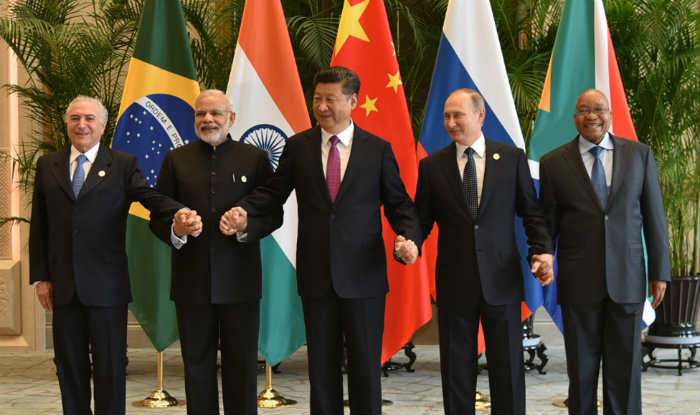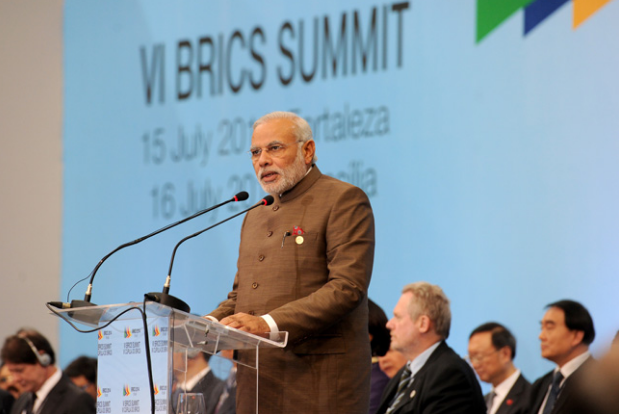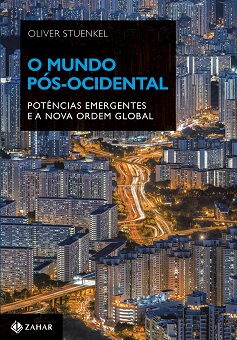
A decade after the Foreign Ministers of Brazil, Russia, India and China met for the first time on the sidelines of the UN General Assembly in New York to discuss global challenges (the 2006 War in Lebanon dominated the conversation back then), India will host the eighth annual Summit of the BRICS countries on October 15-16 in Goa. What can we expect?
Assessing the impact of multilateral summits is notoriously difficult. Observers’ expectations and definitions of success can vary greatly, and, more importantly, it may take years to grasp the ramifications of international agreements. As Henry Kissinger writes in World Order (reviewed here), the 24-hour news cycle and social media make traditional diplomacy far more difficult, and policy makers are forced to provide immediate statements after meetings, providing little space for ideas that go beyond soundbites. For example, the significance of a reduction of non-tariff barriers between BRICS countries can only be adequately assessed once it becomes clear whether it has led to an increase in trade or not.
It does not help that while government-aligned news agencies such as Russia Today (RT) and Xinhua often provide exaggerated praise when writing about the BRICS, Western newspapers such as the New York Times provide remarkably one-sided and excessively critical analyses that regard the grouping as either non-sensical or threatening. The Times‘ recent article about the Goa Summit, titled “Slower Growth, Rivalries Key Issues at BRICS Summit in India” emphasizes the differences between member countries and leaves readers wondering why the meeting takes place at all. Indian newspapers such as The Hindu and the Times of India are the best sources, covering new initiatives and success stories, as well as criticisms of BRICS-related activities, such as when South Africa’s tourism minister was not welcomed by his Indian counterpart during a BRICS meeting in India earlier this year.
While lower growth in China currently dominates the headlines, the notion that the shift of power to emerging powers was temporary is profoundly mistaken. As Jim O’Neill rightly pointed out last week,
(…) the suggestion that the BRICS’ importance was overstated is simply naïve. The size of the original four BRICs economies, taken together, is roughly consistent with the projections I made all those years ago.

Final declarations: Worth the read
The declarations of past summits provide insight, such as the final document of the 2015 Ufa Summit (see my analysis here). The vast majority of pundits commenting on the summit in the coming days will not look at them — after all, they are over one hundred pages long in their entirety.
That is a mistake, for they are worth perusing: A study published last week by the University of Toronto shows that the BRICS achieved 78% compliance with the Ufa Summit Commitments made in 2015, continuing its high rate of compliance from previous summits. The report measures actions taken between 10 July 2015, immediately after the Ufa Summit ended, and 19 September 2016. (Scores may change in the future as new information becomes available.)
Over the past year, BRICS members did best on fulfilling their pledge on competition policy and on tax transparency, with 100% compliance. Members were almost as successful with their commitments on information and communications technology, international cooperation to fight terrorism, and cooperation on agriculture and food for vulnerable populations at 90%. The lowest score came on their regional security commitment on Iraq, at 30%. The full 74-page report in English is available for download at www.brics.utoronto.ca/compliance/2015-ufa.html.
As the authors conclude,
BRICS cooperation has been further deepened and expanded during the Russian presidency. According to the Concept of the Russian Federation’s Presidency in BRICS in 2015, cooperation expanded to include such new areas as parliamentary affairs, culture, and information and communications technologies. Strengthening intra-BRICS cooperation and engagement with other international institutions is a priority. Enhancing “the efficiency of BRICS by improving the reporting process for previous commitments assumed by member countries” is emphasized. Given that collective commitments made at the BRICS summits reflect the members’ shared goals, an increase in the number of commitments and compliance performance could indicate a strengthened capability for collective action.
Specifically, what are the issues likely to appear in the 2016 BRICS Summit’s final declaration?
According to India’s External Affairs Minister Sushma Swaraj, India adopted a five-pronged approach during its Chairmanship, comprising “Institution Building, Implementation, Integration, Innovation, and Continuity with Consolidation.” “Building Responsive, Inclusive and Collective Solutions is the core-theme for our BRICS Chairmanship with a special focus on institution-building, implementing past commitments, and exploring innovative solutions in a spirit of continuity with consolidation,” said a Ministry of External Affairs statement. These statements are fairly generic because new initiatives need to be worked on and agreed on by all five member states before they can be announced at the summit.
Four things, however, seem to be clear:
First of all, India, a stellar economic performer compared to the rest of the world, is using the summit to underline its prime status among emerging powers, growing faster than any other major economy. Indeed, the Indian government is very much aware that it is one of the few places on earth that provides hopeful economic data, lending it enormous legitimacy. India’s GDP per capita is just over 10% of US levels, and even far below China’s GDP per capita. That suggests that the room for catch-up is enormous, and India may be one of the main motors of the global economy in the coming decades. Considering lower growth in China and economic trouble in Brazil, Russia and South Africa, India will easily outshine the other participants at the summit. India’s high growth combined with China’s dominant size will make the BRICS an ever more Asia-centric club (which, it must be said, does not make the grouping less useful for Brazil and South Africa).
Continuing a tradition initiated by South Africa in 2014, India will invite several neighboring countries to participate in a regional outreach meeting after the BRICS Summit. In addition to Afghanistan’s Ashraf Ghani, Bangladesh’s Sheikh Hasina and Myanmar’s Aung San Suu Kyi, leaders from Bhutan, the Maldives, Nepal, Sri Lanka and Thailand have been invited to India.
Secondly, while several new initiatives are likely to be proposed during the summit, the BRICS summit’s focus will be on consolidating existing institutions. The BRICS-led New Development Bank has already made its first loans over the past months, so discussions will focus on details regarding the institution’s structure, lending standards and so on. Still, the strikingly broad number of initiatives is set to continue, and the summit’s website provides lots of useful information. According to India’s Ministry of External Relations, ”People-to-People interactions, business, youth, and sports” were the key priority areas for its BRICS Chairmanship. The BRICS Under-17 Football Tournament, BRICS Film Festival, BRICS Friendship Cities Conclave, BRICS Wellness Forum, BRICS Trade Fair, BRICS Youth Summit, BRICS Think-Tank Forum, BRICS Academic Council etc. were hosted during India’s Chairmanship over the past year. In total, more than 100 BRICS-related events took place. That may be impressive, but also harbors a risk, as it may cause the grouping to lose focus. There is growing evidence that many meetings produce few results, and the grouping’s next host should seek to reduce the quantity of encounters and make clearer what kind of output they should produce.
In addition to further embracing the significance of the NDB, topics discussed in Goa will range from increasing the use of local currencies (something China and Russia desire in particular to reduce their dependence on the US-dollar), the creation of a BRICS-led rating agency, the future of internet governance, the situation in Syria and climate change. With regard to intra-BRICS cooperation, potential topics are reducing visa requirements between member countries, reducing non-tariff barriers to facilitate trade (even though significant progress is unlikely due to domestic resistance everywhere except China), and aligning standards in areas of education, science and technology to make cooperation easier. In addition, a raft of bilateral agreements is likely to be signed in the areas of infrastructure and agriculture, two topics that interest India a lot.
That points to another benefit the yearly leaders’ summit generates — a platform that provides space for a multitude of bilateral meetings to discuss ways to enhance cooperation or ease tensions. As a Russian government advisor pointed out yesterday, “if ten years from now the only thing the BRICS Summits have achieved is to reduce the risk of future conflict between India and China, it will have been a great success.” For Brazil and South Africa, the summits provide unique access to leading policy makers and bureaucrats in Moscow, Delhi and Beijing, which has the potential to generate ample benefits as the shift of power towards Asia continues in the coming years.
Finally — and this won’t surprise anyone who has studied the topic — the BRICS grouping has long turned into something far greater than the majority of Western analysts likes to concede, and institutionalization makes its continued existence for years to come extremely likely. While pundits writing articles titled “Forget the BRICS” still believe the main glue between the grouping’s members is high economic growth (and that it should, consequently, cease to exist given today’s lower growth rates), institutionalization has advanced far more than any Western mainstream analysts would have expected. The BRICS Summit is now among the major pillars of the yearly travel schedule of any member country’s President, irrespective of ideological orientation — as Brazil’s case shows. Michel Temer, Brazil’s center-right president, is the first leader of his country to visit Asia twice in the first months of his mandate. Indeed, while even those initiatives that make it into the final document are at times uncertain to bear any fruits, all this points to the continued overall trend to expanding, not reducing, intra-BRICS cooperation.
Read also:
The Ufa Declaration: An analysis
Post-Western World: How Emerging Powers are Remaking Global Order
BRICS: the survivor (Public Finance)
Do the BRICS possess soft power?
Photo credit: Beto Barata/PR, PM Shree Narendra Modi Ji addressing BRICS SUMMIT








